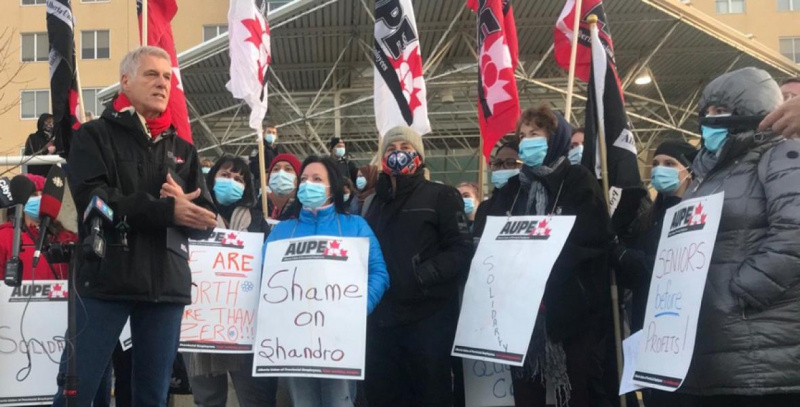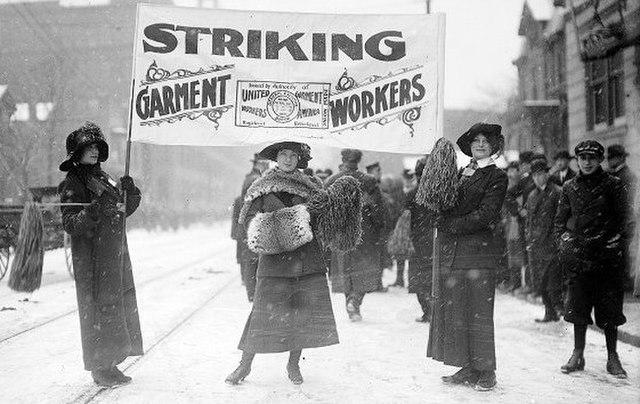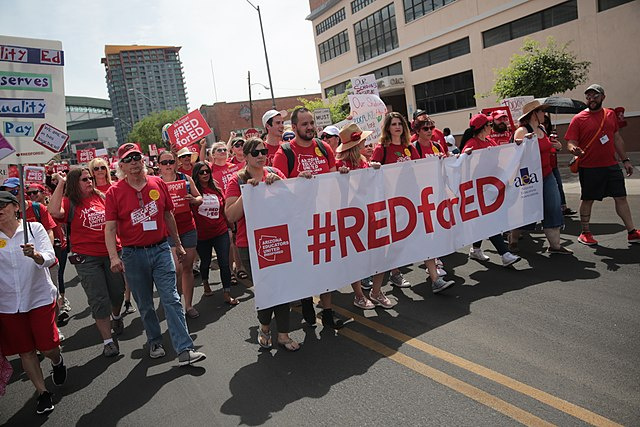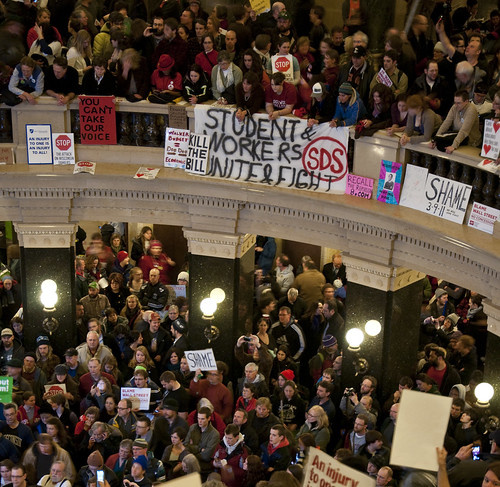By Jon Milton, Communications Staff
At the 2019 convention of the Alberta Union of Provincial Employees, delegates debated a critical motion that would change the future of the union—particularly on the path to war with the austerity-crazed provincial government.
After outlining the many ways that the UCP was attacking AUPE members and all workers in Alberta, the motion concluded with a resolution that “any group(s) of members that take effective collective direct action to protect their rights, livelihood and services to Albertans will be fully supported by AUPE and its membership.”
The results were overwhelming: unanimous support for direct action.
“Where working people’s power lies is on the job, not at the ballot box. If you accept that logic, then you need to be able to demonstrate power in the workplace.”
So, why was the vote so enthusiastically in favour? For years, AUPE has been building on its mission to mobilize members to stand together in strength and solidarity. Mobilization has become part of who we are and what we do. It should be no surprise then, that members at AUPE’s convention embraced direct action as a natural extension of the mobilizing efforts we have all been committed to.

So, what is direct action anyway?
“Where working people’s power lies is on the job, not at the ballot box,” says Peter Cole, a historian at Western Illinois University. “If you accept that logic, then you need to be able to demonstrate power in the workplace.”
Direct action is the power of workers cooperating directly with each other to fix problems at work and challenge employer abuses, and workers have been using it for centuries.
“Direct action means different things to different people,” says Guy Smith, president of AUPE. “At its most basic, it means a collective action—workers banding together to solve a workplace or bargaining issue, and doing it themselves when other avenues are insufficient or have failed.”
“It’s the purest form of worker democracy on the shop floor,” Smith says. “Traditionally, a lot of unions have been nervous about giving workers that kind of power. But we’re trying to build it. It’s becoming part of our DNA.”

Types of Direct Action
There are many types of direct action, but when it comes to worker-led direct action, they fit into three broad categories.
Workplace Direct Action
“Workplace direct action is really where the building blocks are for those other larger types of direct action,” Smith says. “It’s really designed to resolve a problem that a group of workers are facing—whether it’s short-staffing, bullying and harassment, or unsafe working conditions.”
Workplace direct action takes place outside the context of collective bargaining, and it’s a type of worker-action with a long history in the labour movement. It’s a tool that allows for workers to address issues as they arise on the shop floor.
We all have problems at our jobs. Some of those problems are individual, like having a discrepancy on your paycheque. But when the problems are collective, like short-staffing or over-reliance on mandatory overtime, that’s when we have the chance to start planning direct actions.
“The variety of issues is as expansive as the variety of worksites that we have, and the variety of members that we have,” Smith says. “Workers have relationships on the workplace, and planning direct action is about using those relationships to come to a common strategy or goal to address a common problem.”
“Workplace direct action is really where the building blocks are for those other larger types of direct action. It’s really designed to resolve a problem that a group of workers are facing—whether it’s short-staffing, bullying and harassment, or unsafe working conditions.”
The tactic depends on the workers planning the action. It could mean staging a sit-in during a shift change to protest mandatory overtime, or everyone wearing the same color shirt on a specific day. The key is collective planning for at-work action.
According to Cole, direct actions can be on a smaller scale. “You can have a number of workers in a workplace who decide to withhold work, to slow down, or to take action together,” he says. “Maybe they’re demanding to hire more people or trying to fix a safety issue. But the important thing is that they’re making demands.”
As Smith says, sometimes it makes sense to use the grievance system to solve problems at work, particularly when the problem is individual. Grievances can also help test out the collective agreement and see where language needs to be improved to better protect workers.
But the grievance system has obvious drawbacks. It’s long, and workers don’t directly control the process, experts from management and unions do.
When you identify a problem to solve by direct action (see the checklist below), you can get the boss to fix things quickly.

Direct Action for Bargaining
“Direct action for bargaining is different than workplace direct action, in that it needs a higher level of coordination,” Smith says. “Bargaining can cover many different worksites, with many different types of workers, with many different demands. So there needs to be even more coordination across those lines. Building that unity is really important.”
Approaches vary: wearing the same colour on specific days, as teachers have done with the #RedForEd campaign, chanting “solidarity!” at set time, mass-signing petitions supporting our bargaining committees, and going to the boss’s office together to present them.
Recently, AUPE members at a continuing care home conducted that sort of “march on the boss.” Their worksite had major COVID outbreaks, and they were in the middle of bargaining. The employer’s offer was insulting, and after so much collective grief over the course of the pandemic, they decided to take action.
Workers began organizing by mapping their worksite and collecting contacts from every shift on every floor. When they created a petition demanding that the employer offer a better deal for their next collective agreement, over 70 per cent of the entire workforce signed, and nearly the entire shift marched on (and stunned) the boss. That momentum inspired workers to fight harder for a better contract.
Of all direct actions, none is more powerful than the strike “A strike is obviously a kind of direct action,” Smith says, “but sometimes the best way to build up a workplace is smaller direct action to build that capacity and confidence. With that confidence, we can move on to bigger action, and win bigger gains.”

Political Direct Action
Although it’s furthest from the worksite, political direct action is still a key tactic, especially because the UCP government has been passing legislation to strip our rights at work since they came to power. Political direct action is how we fight legislative attacks.
“Political direct action is about members realizing that politics affects them all the time in their work lives,” Smith says. “It’s a matter of taking those process to the decision-makers, and showing them we’re serious, just like we would to an employer.”
AUPE members have some experience with this type of direct action as well, Smith says. “We occupied the Health Minister’s constituency office in an action against long term care privatization,” he says. “Man, did those workers feel powerful!”
Whether direct action is at work or in the political arena, Cole notes, “I’m really interested in not only workers and how they have power, but what they use it for. Maybe we get more money, maybe we get health insurance, but what can workers do to exert power and shape conversations about social justice in their own countries and across the world? The idea that we need to defer to elected officials or whatever is bogus.”

Questions to ask yourself—and your co-workers!
To prepare for direct action, first ask yourself a few questions.
First, what’s the worksite problem? How many people does it affect? How often? Is it isolated or widespread?
Second, how angry are you—and your co-workers—about this problem? If people care only a little, you don’t have enough fuel to get to your destination. But if the abuse they face is serious, especially if it’s longstanding, you could quickly accelerate your direct action vehicle from 0 to 100.
Third, how far are you willing to go to resolve the problem, and what are the risks you’re willing to take?
Fourth, what do you want specifically—your perfect list, and your minimum compromise?
Of course, these aren’t questions you can answer on your own. You and your co-workers who know there’s a problem—and a solution—need to talk to all your other colleagues one–to-one, build contacts across your worksite, and plan everything collectively.
“In a practical sense,” Smith says, “we haven’t even scratched the surface of our members potential of using direct action as a tool in the strategy toolbox. This is a new orientation for us, and we’re only just warming up.”
Cole agrees that the path to direct action requires growth, experimentation, and discovery. “Direct action is about workers coming to know their power,” he says. “It’s one thing to know that you have power on a theoretical level, but it’s another thing to experience it firsthand. That’s what direct action does—from small-scale workplace issues to international solidarity, direct action is how workers can exercise their power.”

